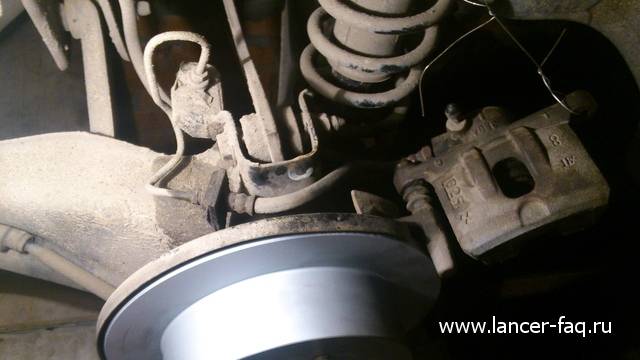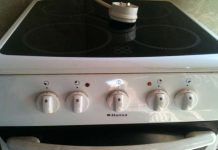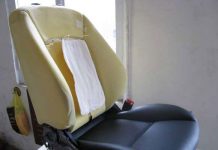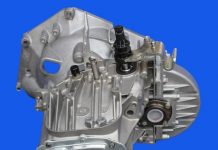In detail: do-it-yourself repair of rear calipers Lancer 9 from a real master for the site my.housecope.com.
Content
First, rip off the bolts, then lift the car and remove the wheel, then unscrew the two caliper guides.
Next, with the help of a clamp, we block the brake line. Here you need to be careful not to damage the brake hose. Then unscrew the union and dismantle the caliper.
After the caliper is removed, we inspect the brake cylinder oil seal for damage, leaks. In this case, we have a leak.
We start disassembling the caliper.
Using a flat screwdriver, we remove the oil seal.
After the oil seal is removed, you need to remove the gasket, which is located inside the caliper.
The gasket is removed. The condition of the caliper walls is assessed as normal.
The condition of the oil seal requires replacement.
At this stage, we figured out the caliper. We proceed to inspect the guides. On the right is a new one, on the left is an old one. As you can see in the image, a replacement is needed.
After evaluating the parts of the caliper, we proceed to cleaning the cylinder from dirt and TG.
After cleaning, the status can be determined. The state of the norm.
We assemble the caliper in the reverse order, installing a new internal rubber band, a metal ring and an external oil seal on it.
Next, we replace the guides. We advise you to grease the guides liberally at the beginning of the installation.
Having installed the brake caliper in place, we tighten all the bolts, and return the union to its original position.
| Video (click to play). |
On cars Mitsubishi lancer during maintenance and checking the performance of the brake system, in addition to replacing brake pads and discs, it may also be necessary to replace the brake caliper guides, as well as to check the functioning of the piston under load.
If it is untimely to replace the brake pads and do not monitor the condition of the brake system, you may encounter the following problems: extrusion of the brake cylinder, souring of guides.
These two factors, plus an aggressive driving style, lead to the fact that the cylinder does not return to its original position, the oil seal collapses, and the brake fluid leaks. As a result, we have a faulty braking system and a car that cannot be driven.
For work you will need:
Catalog number of the original front caliper repair kit Lancer 9 - Mitsubishi MR 527672 (average price 640 rubles). Analogs: Frenkit 260037 (205 rubles), Febest 0475-CS3F (450 rubles), Autofren D4908 (240 rubles) and others.
Catalog number of the original rear caliper repair kit Lancer 9 - Mitsubishi MR 955067 (average price 670 rubles). Analogues: Febest 0475-NA4R (380 rubles), Quattro freni QF41F00001 (550 rubles), Deppul DERE133M (375 rubles) and others.
Once everything is assembled, press the brake pedal a couple of times to bleed the brakes.
The cost is indicated as of prices for the summer of 2017 for Moscow and the region.
You will need: socket wrenches "12", "14".
1. Remove the wheel from the side of the caliper being replaced.
2. Unscrew the upper bolts.
3.. and the lower attachment of the caliper to the trailing arm.
4. While holding the hose tip with a wrench, unscrew the caliper from the tip.
5. Install the caliper in the reverse order of removal.
If there are scoring, deep marks and other defects on the working surface of the disc that increase the wear of the pads and reduce the braking efficiency, as well as in the case of increased lateral runout of the disc, which causes vibration during braking, replace the disc.
The minimum permissible brake disc thickness is 8.4 mm. If one of the discs is less than specified, replace both discs. When replacing brake discs, be sure to replace the brake pads with a new set.
1. Remove the wheel from the side of the disc to be replaced.
2. Unscrew the lower guide pin of the caliper, lift the caliper up (see."Replacing brake pads").
3.. wire the brake caliper to the spring to keep it from falling.
4. . and remove the brake disc.
5. If you cannot remove the brake disc by hand, press it off the hub by evenly screwing the appropriate bolts into the two threaded holes of the disc.
6. Establish a brake disc in the reverse order of removal.
Before installing the disc, thoroughly clean the mating surfaces of the hub and disc from rust and scale, since even the smallest particle trapped between the mating surfaces will cause the disc to run out and vibrate during braking.
If you are installing an old disc, remove with a file the beads on the running surfaces of the disc, which have formed on both sides of the disc as a result of wear.
This is how the brake pads of the rear working brake look like: 1,5-vi-damping plates; 2 - thermal insulation plate; 3 - outer brake shoe with a pressure spring; 4 - inner brake shoe; 6 - distance plate; 7 - brake pad wear indicator. The outer and inner pads of the rear service brake have different designs and are not interchangeable.
Whenever you replace the brake pads, be sure to check the condition of the protective rubber covers of the guide pins, as well as the ease of movement of the caliper relative to the brake pad guide. If movement is difficult, lubricate the guide pin and its boot with grease. For this.
... Unscrew the guide pin from the caliper and lubricate it with grease.
Remove the guide pin protective cover and also lubricate the inside with grease.
7. Remove the upper and lower retaining springs from the shoe guide.
8. Using pliers, press down the cylinder piston.
9. Install the retaining springs, brake pads and other removed parts in the reverse order of removal.
10. Replace the brake pads of the brake mechanism of the right wheel in the same way.
11. Check and, if necessary, restore the level of the brake fluid in the reservoir of the master brake cylinder.
Replacing the rear brake caliper
You will need: socket wrenches "12", "14".
1. Remove the wheel from the side of the caliper being replaced.
2. Unscrew the upper bolts.
3.. and the lower fastening of the caliper to the trailing arm.
4. While holding the hose tip with a wrench, unscrew the caliper from the tip.
5. Install the caliper in the reverse order of removal.
Replacing the rear brake disc
If there are scoring, deep marks and other defects on the working surface of the disc that increase the wear of the pads and reduce the braking efficiency, as well as in the case of increased lateral runout of the disc, which causes vibration during braking, replace the disc.
The minimum permissible brake disc thickness is 8.4 mm. If one of the discs is less than specified, replace both discs. When replacing brake discs, be sure to replace the brake pads with a new set.
1. Remove the wheel from the side of the disc to be replaced.
2. Unscrew the lower guide pin of the caliper, lift the caliper up (see "Replacing the brake pads", page 178).
3.. wire the brake caliper to the spring to keep it from falling.
4. „.and remove the brake disc.
5. If you cannot remove the brake disc by hand, press it off the hub by evenly screwing the appropriate bolts into the two threaded holes of the disc.
6. Establish a brake disc in the reverse order of removal.
Before installing the disc, thoroughly clean the mating surfaces of the hub and disc from rust and scale, since even the smallest particle trapped between the mating surfaces will cause the disc to run out and vibrate during braking.
If you are installing an old disc, remove with a file the beads on the running surfaces of the disc, which have formed on both sides of the disc as a result of wear.
Replacing the parking brake pads
You will need: pliers, flat-blade screwdriver. 1. Remove the left rear wheel.
In Mitsubishi cars, when servicing and checking the functioning of the brake system, in addition to replacing brake pads and discs, there is a very important procedure for replacing the brake caliper guides and checking the piston's performance under load. SKR-AUTO specialists are ready to offer you 2 types of procedures for servicing the brake system on Lancer 9 and Lancer 10 cars.
Standard (Brake Caliper Service) - Lubrication and replacement of the brake caliper guides. This procedure is necessary to return the brake pads to their original position. The harsh climate, reagents eventually wash out the lubricant, wear out the parts, and subsequently disrupt the correct operation of the brake caliper, and then breakdown of the brake mechanism.
Maximum (brake caliper bulkhead) - Replacing the piston oil seal and guides with subsequent lubrication.
In case of untimely replacement of brake pads and neglect of maintenance of the brake system, the following detrimental processes occur: 1. Extrusion of the brake cylinder and 2. Souring of the guides. All this, combined with the harsh operating conditions, leads to the fact that the cylinder stops returning to its original position, the oil seal collapses, and the brake fluid leaks. As a result, we have a faulty braking system and a car that cannot be driven.
Name of works
Service of the brake system on Mitsubishi Lancer X cost:
Name of works
Correct operation of the vehicle's braking system is very important and self-explanatory. Harsh operating conditions, driving style, reagents destroy the braking system over time. The working part of the brake system (calipers, pads, discs) of the car requires regular maintenance, otherwise a crackle appears when the calipers work, the braking efficiency decreases, and the wear of the pads and discs increases. In the absence of timely maintenance, leaks may occur in the brake system, the braking efficiency will decrease, or, on the contrary, the brake caliper will jam. Below, for you, we will describe in detail the procedure for servicing the Mitsubishi brake system.
1. Remove the wheel in order to be able to get to the brake system. Unscrew the 2 caliper guides. If the bolts stick together, treat them with WD-40 and wait a while, then try unscrewing again.
2. We use a clamp to close off the brake line (note: this operation requires care, otherwise it is possible to damage the brake hose). We unscrew the union and remove the caliper.
3. We inspect the brake cylinder oil seal. The photo shows a leak. We proceed to disassemble the caliper.
4. We use a flat screwdriver to remove the old oil seal, it is recommended to carry out this operation with gloves.
5. After removing the outer oil seal, it is necessary to pull out the inner gasket located inside the brake caliper. In the picture on the right we see the state of the cylinder walls (note: in this case, the state of the brake caliper is normal).
6. Put aside the caliper and start inspecting the guides. The photo shows that the guides are worn out and need to be replaced. On the right, for comparison, a new guide is presented (note: some motorists grind the guides with sandpaper, without resorting to replacing - this is not recommended, since the metal grinds during processing, and as a result, after assembling the caliper, you will get a backlash in the grooves of the guides). The photo on the right shows the cylinder oil seal, it is damaged and needs to be replaced.
7. After assessing the components of the caliper, you can proceed with the repair. Let's start by cleaning the cylinder from dirt and brake fluid, and at the same time determine its condition.
8. Required parts are sold with a brake repair kit. It contains all the necessary components (note: brake caliper rails are sold separately).
9.Using an internal rubber band, a metal ring and an external oil seal, we assemble the brake caliper in the reverse order (note: treat the oil seal with a special grease that protects the rubber and at the same time helps to insert the brake cylinder into place). On the right, the picture shows the assembled brake caliper.
9. We are replacing the guides. The guides must also be generously lubricated before installing on the vehicle. After returning the brake caliper to its place, tighten all the bolts, return the union to its place. Check the correct assembly (note: after overhauling the brakes, bleed the brake system in order to expel air).
Brake caliper service complete. You can perform this operation yourself by ordering the necessary parts, but there are certain difficulties during the work. SKR-AUTO specialists have tremendous experience in working with Mitsubishi cars, they will professionally service your braking system, and save your time and effort.
The caliper is a separate system in the car, the functional purpose of which is to provide smooth braking of the vehicle, regardless of the speed limit and the type of road surface.
The support system is an essential element for the safe operation of the vehicle. In the case of the selection of components, it is important to select parts solely by the VIN number of the car. Or by checking parts for compatibility - otherwise, the effectiveness of the braking system is significantly reduced.
ATTENTION! Found a completely simple way to reduce fuel consumption! Don't believe me? An auto mechanic with 15 years of experience also did not believe until he tried it. And now he saves 35,000 rubles a year on gasoline! Read more"
The set of caliper repair kit includes a wide list of elements necessary for high-quality brake restoration, even in "handicraft" conditions. The original repair kit includes:
- Guide grease (colored orange);
- Caliper piston grease (painted red);
- Cuffs for the piston;
- Protective bellows for guides and piston boot;
- Anther wire ring.
The functional purpose of the repair kit is to restore the trouble-free operation of the piston. For this, it is necessary to polish the working surface of the product and replace the protective inserts. If it is impossible to polish the coating of the piston due to its mechanical deformation, the part will have to be replaced with a new one.
The procedure for installing new car calipers will take about an hour per wheel. To replace parts, you will need a set of wrenches and sockets, a set of slotted screwdrivers, pliers, a hammer, as well as WD-40 grease, a coil of wire and molar tape to facilitate installation.
In order to change the calipers on the Mitsubishi Lancer 9, you must:
- Drive the car onto an inspection pit or lift. You can also use a jack, you will have to install an additional emphasis under the car;
- Then we de-energize the vehicle by disconnecting the ground terminal from the battery;
- Next, we remove the wheel, after which we use a “14” wrench to unscrew the fastenings of the lower caliper pin. After loosening, we lift the part up to the car fender liner and fix the position with a wire to facilitate further repairs;
- We unscrew the union from the brake pipe. Then we plug the spare part with a rubber seal or a clean rag to prevent brake fluid leakage;
- Next, the branch pipe union is dismantled by unscrewing the fixing brackets on the part with a wrench. At this stage, it is important not to rip the fasteners off the fitting. Otherwise, you will have to change the product to a new one. To simplify the unwinding procedure, the threads can be sprinkled with WD-40 liquid and the part can be left to turn off for 20 minutes;
- At the end of the preparatory procedures, access to the caliper will open, which must be pushed sideways to the spring, and then removed. Also, at this stage, you need to remove the finger and the brake pipe.
If a new set of calipers is installed, we change the part to a new one and assemble the structure in the reverse order.
Self-repair of the vehicle's braking system allows not only to minimize maintenance costs in the workshop. And also to be confident in the trouble-free functioning of the brakes. To restore the effectiveness of the car's brakes, it is required:
- With the caliper dismantled, we disassemble the structure and proceed to replacing the brake piston boot. To do this, pry the wire ring of the fixing bracket with the tip of a slotted screwdriver and take out the part. Installing a new boot is required in the same position as the previous one;
- Next, we remove the piston. It is recommended to dismantle the device with the brake pipe not disconnected: pressing the piston a couple of times on the pedal, the piston will gently fall out of the slots. To prevent deformation of the product, it is advisable to cover the place of possible fall with rubber or rags;
Note! If the piston is disassembled with the hose disconnected, to remove the part, you will have to create excess pressure in the brake system. This can be done with an electric pump. It is important to remember that when removed, the piston may fire.
- At the end of the procedure, we polish the coating of the piston with a machine or several layers of sandpaper, after which we clean the grooves of the part from rust and install new anthers;
- Next, we lubricate the parts with the appropriate type of grease and you can begin the reinstallation procedure. The assembly takes place in a strictly reverse sequence of actions.
Gender: husband
Mitsubishi Lancer IX
2) The second guides do not move apart the rear caliper bracket - clean the guides and the holes in which they enter with a zero foot and lubricate VD40
1. We buy a caliper repair kit
2. Remove the caliper, bracket, guides, pull out the piston.
3. We clean the guides, the bracket (grooves for the pads), if necessary (the presence of rust) - the piston.
4. Assemble the caliper by lubricating the guides and piston with grease from a repair kit or other high-temperature caliper guides, for example Permantex.
5. We put the caliper, pump the brake fluid and rejoice.
The WD-40 cannot be used because it is not a lubricant, but kerosene with additives. In addition to the fact that it does not have impenetrable lubricating properties in the entire temperature range, it also adversely affects the rubber boots and the bushing of one of the caliper guides, which swells, thereby wedging the guide and the caliper stops moving.
1. We buy a caliper repair kit
2. Remove the caliper, bracket, guides, pull out the piston.
3. We clean the guides, the bracket (grooves for the pads), if necessary (the presence of rust) - the piston.
4. Assemble the caliper by lubricating the guides and piston with grease from a repair kit or other high-temperature caliper guides, for example Permantex.
5. We put the caliper, pump the brake fluid and rejoice.
The WD-40 cannot be used because it is not a lubricant, but kerosene with additives. In addition to the fact that it does not have impenetrable lubricating properties in the entire temperature range, it also adversely affects the rubber boots and the bushing of one of the caliper guides, which swells, thereby wedging the guide and the caliper stops moving.
Lubrication of the guides, replacing the boot of the brake cylinder Lancer 9 (Lancer IX) | Mitsubishi Lancer IX, Lancer 9, wagon, classic
Hello everyone.Site> presents to our visitors a report on lubricating the guides and replacing the boot cylinder of the Lancer 9 brake caliper.
1. For lubrication of the guides and replacement of the boot of the brake cylinder Lancer 9 we need the following materials and spare parts.
Front Caliper Guides
- upper MR407742
- lower MR407741
Repair kit MR527672
Guide grease
ATTENTION for the lubrication of the guides, it is the lubricant for the guides, and not any other anti-squeak, etc., is required. grease (which is mistakenly indicated in the photographs).
Very good grease for guides Lancer 9: Permatex 09977.
Anatoly also advises in the comments the lubricants “Loctite Teroson Plastilube”, “ATE plastilube” (and, by the way, I advise you to read his commentary)
2. Open the hood Lancer 9. Unscrew the cap from the brake fluid reservoir. We remove the wheel, spray WD-40 onto two caliper mounting bolts, wait a couple of minutes, unscrew the bolts, remove the Lancer IX caliper, remove the old pads, remove the old rubber bands and guides, clean everything with a brush, and this is what we get:
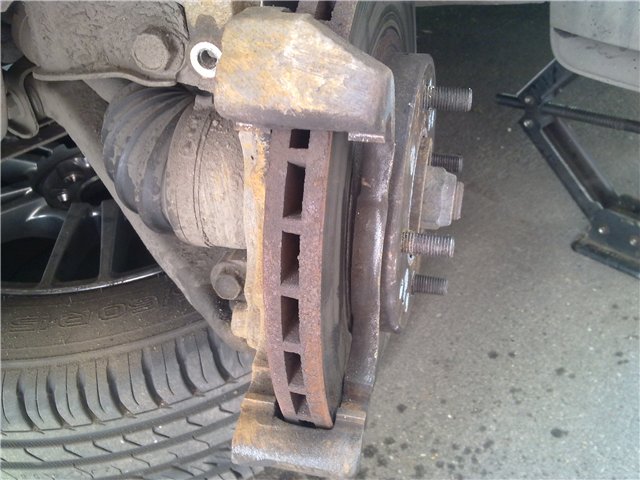

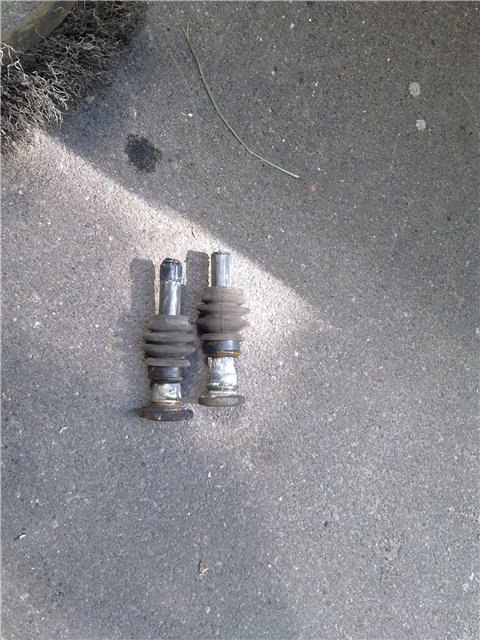


3. Carefully !! Remove the caliper piston gum. If removed carefully, it will come off with the ring! Neat and smooth. we press the brake pedal so that the caliper piston comes out a bit forward. Then we remove any dirt and shit that got there (from the wear of the gum or simply from its rupture), lubricate the piston with the grease that goes in the repair kit
Then we put on an elastic band! First, on the caliper piston itself! DON'T MIX WHICH OVERWEAR TO WEAR! Be careful.
Then push the piston back a little bit with a pry bar. And we carefully tuck the upper part of the new gum inward. When wearing, the elastic on the piston can be twisted slightly. This is more comfortable. Then carefully put on the ring and tuck it in with a small, not sharp screwdriver. It will fit into the grooves. This will be understood by the characteristic sounds and position. Here's what you get:
Attention, the picture below shows the correct position of the retaining ring in the boot of the brake cylinder:
Then we add lubricant to the new rubber bands.
Then we smear a little new guides.
Don't forget to clean the staples !!
Next, insert the pads (for me they are so glamorous !!)
Lubricate the Lancer 9 caliper mounting bolts and assemble the entire structure.
We check everything, spin the wheels and go to the back!
The back is a little different. But nothing complicated!
Removing the rear wheel! Spray again with WD-40 on the twisted guides!
We unscrew and take out (with great difficulty, because there was no lubricant there at all) the lower guide It makes no sense to take a photo, and it is so clear what is there.
Next is the top guide….
However, the top guide cannot be pulled out! And that's why!
We run into the brake pipe! And you need to take it out, because THERE IT'S DRY EVERYWHERE! Yes, it happens. We take the 17 key, loosen the tightening of the brake pipe, and now, after weakening a little (yes, that's right), we take out the caliper with the guide!
Sorry, the photo turned out to be a fig, but in general it is understandable! The support in the hands is still screwed to the tube. Then, rotating the CAM SUPPORT, unscrew it from the tube. We plug the pipe!
These are the guides that turned out to be ... not beautiful ... but not rough.
Better to change to new ones. I just didn’t have new ones and it didn’t work to buy. But it seems that these were also cleaned, cut off and oiled.
Then, carefully, like in front, we look at the presence of grease on the caliper piston. I didn’t have it, but the rubber band of the piston is intact on one side and the other! I filled them with grease for the piston. Grease remains from the front repair kit. There is enough of it in the bag!
If you are going to shoot, like me, the caliper and unscrew the tube, do it very carefully. Clean the caliper and gently unscrew and tighten the bleeder with a head of 8! Then we twist the upper guide with the rubber band, ROTATING THE SUPPORT ITSELF, screw it to the brake pipe, put everything in place! We put a support, tightened the tube with a key to 17! Then we put new pads, put on the caliper, insert the greased lower guide along with the rubber band in which there is also grease, and screw everything up.
DRAW YOUR ATTENTION! When everything is assembled, it is imperative to bleed the rear brakes. Ask a friend to help.We slightly unscrew the bleed nipple, a friend presses the pedal all the way and holds it, and at this time you see the air coming out, tighten the nipple, a friend pumps up the pedal, you unscrew the nipple, his pedal falls through, the brake leaks from the nipple, you twist the nipple, the friend lets go pedal. And once again (preferably two) do this procedure to secure it. Everything. You can collect everything. We put the wheel. Add some brake fluid to the reservoir and go to the other side.
Everything. Good luck to all! Do not forget about the brakes guys, because smart cowards came up with them!
We present to your attention the process of repairing a front brake caliper on a Mitsubishi Lancer 9. The work is carried out in the Mitsubishi locksmith shop on the basis of the NIVUS car service.
1. Installation of the car on a lift.
2. Removing the front wheel.
3. Removing the brake caliper. The bolt securing the lower guide is unscrewed.
4. Removing the caliper. The caliper is dismantled together with the upper guide.
5. The process of repairing a Mitsubishi car. After squeezing the brake hose with a squeeze, the union is unscrewed from the brake caliper.
6. Removing the brake piston. The brake piston is removed with a special puller.
7. Dismantling the old parts of the caliper. The torn boot and the old cuff are dismantled.
8. Cleaning the brake caliper. Rust and dirt are carefully cleaned.
9. Spare parts of the Mitsubishi car. On the left is a set of spare parts to be replaced, on the right is the old “faulty” one.
10. Installation of new spare parts for the caliper. A new cuff and boot are installed in place.
11. Installing a new brake piston. Having previously lubricated the caliper with grease from the repair kit, a new piston is inserted.
12. New brake caliper guides.
13. The guides are lubricated with special grease.
14. Installation of new guides. The guides are inserted into the brake caliper.
15. Installing the caliper on the car. The brake union is screwed on.
16. Installing the brake caliper on the car. The 2 bolts securing the brake caliper to the rails are tightened.
17. The brake fluid level is checked.
18. Bleeding the brake system of a Mitsubishi car. With the help of a special tool, the brake system is pumped.
19. Checking the brake fluid level. Then, if necessary, the brake fluid is topped up.
20. Wheels are installed, the tightening torque is checked with a torque wrench.
21. The final stage of the repair. The car is removed from the lift, it is ready for use.
Your attention is given to the instructions for replacing the brake caliper on a Mitsubishi Lancer 9. And so, to begin with, we jack up the car (front or rear as needed). Bolts located on the metal part in the center of the wheel, unscrew them, remove the wheel.
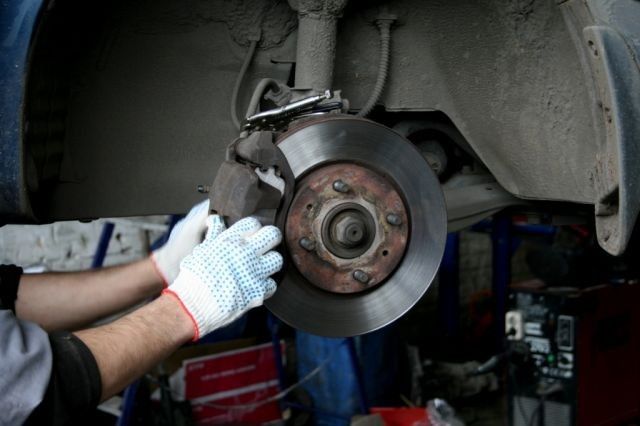
The caliper has guides - 2 pcs. We unscrew them.
The next step is to block the brake line, but we advise you to first block it with a clamp. Be careful not to damage anything.
Then unscrew the union and remove the caliper.
The cylinder brake oil seal is now in front of your eyes, you need to conduct a thorough inspection. If it is damaged or there may be a place where it is leaking, then immediately start disassembling it. Of course, if there is no damage, then we can calmly proceed to the next step. But we came up with a problem and came up with a leak.
We disassemble the caliper, we need to remove the oil seal, a flat screwdriver will help in this matter.
Once you have completed the task, do not forget to remove the gasket inside the caliper.
We examined it again, paid attention to the walls, it is necessary that there was no damage.
In our case, there is a problem - in the photo you will see an oil seal, and a significant hole in it.
The guide at the very beginning of his journey looks new. In the photo where the oil seals are shown, you clearly observe the difference between outdated and new. Better to replace it. Rusty damage and chips are visible from below.
We have checked all the parts of the caliper. What needs to be replaced and now we turn to cleaning the cylinder.
Next, you see that the repair kit for the assembly is new, it consists of an internal rubber band, metal. Rings and external oil seal. Putting everything together in the reverse order.
Now we will change the guides themselves. We lubricate them well. We return the caliper to its place, we tighten the bolts that we unscrewed at the beginning.
Brake pads need to be changed in a timely manner, otherwise the guides can sour and not only this problem can arise.
The price of a repair kit ranges from two hundred to four hundred rubles.
Lubrication of the guides, replacing the boot of the brake cylinder Lancer 9 (Lancer IX) | Mitsubishi Lancer IX, Lancer 9, wagon, classic
Hello everyone. Site> presents to our visitors a report on lubricating the guides and replacing the boot cylinder of the Lancer 9 brake caliper.
1. For lubrication of the guides and replacement of the boot of the brake cylinder Lancer 9 we need the following materials and spare parts.
Front Caliper Guides
- upper MR407742
- lower MR407741
Repair kit MR527672
Guide grease
ATTENTION for the lubrication of the guides, it is the lubricant for the guides, and not any other anti-squeak, etc., is required. grease (which is mistakenly indicated in the photographs).
Very good grease for guides Lancer 9: Permatex 09977.
Anatoly also advises in the comments the lubricants “Loctite Teroson Plastilube”, “ATE plastilube” (and, by the way, I advise you to read his commentary)
2. Open the hood Lancer 9. Unscrew the cap from the brake fluid reservoir. We remove the wheel, spray WD-40 onto two caliper mounting bolts, wait a couple of minutes, unscrew the bolts, remove the Lancer IX caliper, remove the old pads, remove the old rubber bands and guides, clean everything with a brush, and this is what we get:





3. Carefully !! Remove the caliper piston gum. If removed carefully, it will come off with the ring! Neat and smooth. we press the brake pedal so that the caliper piston comes out a bit forward. Then we remove any dirt and shit that got there (from the wear of the gum or simply from its rupture), lubricate the piston with the grease that goes in the repair kit
Then we put on an elastic band! First, on the caliper piston itself! DON'T MIX WHICH OVERWEAR TO WEAR! Be careful.
Then push the piston back a little bit with a pry bar. And we carefully tuck the upper part of the new gum inward. When wearing, the elastic on the piston can be twisted slightly. This is more comfortable. Then carefully put on the ring and tuck it in with a small, not sharp screwdriver. It will fit into the grooves. This will be understood by the characteristic sounds and position. Here's what you get:
Attention, the picture below shows the correct position of the retaining ring in the boot of the brake cylinder:
Then we add lubricant to the new rubber bands.
Then we smear a little new guides.
Don't forget to clean the staples !!
Next, insert the pads (for me they are so glamorous !!)
Lubricate the Lancer 9 caliper mounting bolts and assemble the entire structure.
We check everything, spin the wheels and go to the back!
The back is a little different. But nothing complicated!
Removing the rear wheel! Spray again with WD-40 on the twisted guides!
We unscrew and take out (with great difficulty, because there was no lubricant there at all) the lower guide It makes no sense to take a photo, and it is so clear what is there.
Next is the top guide….
However, the top guide cannot be pulled out! And that's why!
We run into the brake pipe! And you need to take it out, because THERE IT'S DRY EVERYWHERE! Yes, it happens. We take the 17 key, loosen the tightening of the brake pipe, and now, after weakening a little (yes, that's right), we take out the caliper with the guide!
Sorry, the photo turned out to be a fig, but in general it is understandable! The support in the hands is still screwed to the tube. Then, rotating the CAM SUPPORT, unscrew it from the tube. We plug the pipe!
These are the guides that turned out to be ... not beautiful ... but not rough.
Better to change to new ones. I just didn’t have new ones and I didn’t manage to buy. But it seems that these were also cleaned, cut off and oiled.
Then, carefully, like in front, we look at the presence of grease on the caliper piston. I didn’t have it, but the rubber band of the piston is intact on one side and the other! I filled them with grease for the piston. Grease remains from the front repair kit. There is enough of it in the bag!
If you are going to shoot, like me, the caliper and unscrew the tube, do it very carefully. Clean the caliper and gently unscrew and tighten the bleeder with a head of 8! Then we twist the upper guide with the rubber band, ROTATING THE SUPPORT ITSELF, screw it to the brake pipe, put everything in place! We put a support, tightened the tube with a key to 17! Then we put new pads, put on the caliper, insert the greased lower guide along with the rubber band in which there is also grease, and screw everything up.
DRAW YOUR ATTENTION! When everything is assembled, it is imperative to bleed the rear brakes. Ask a friend to help. We slightly unscrew the bleed nipple, a friend presses the pedal all the way and holds it, and at this time you see the air coming out, tighten the nipple, a friend pumps up the pedal, you unscrew the nipple, his pedal falls through, the brake leaks from the nipple, you twist the nipple, the friend lets go pedal. And once again (preferably two) do this procedure to secure it. Everything. You can collect everything. We put the wheel. Add some brake fluid to the reservoir and go to the other side.
Everything. Good luck to all! Do not forget about the brakes guys, because smart cowards came up with them!
You will need: socket wrenches "12", "14".
1. Remove the wheel from the side of the caliper being replaced.
2. Unscrew the upper bolts.
3.. and the lower attachment of the caliper to the trailing arm.
4. While holding the hose tip with a wrench, unscrew the caliper from the tip.
5. Install the caliper in the reverse order of removal.
If there are scoring, deep marks and other defects on the working surface of the disc that increase the wear of the pads and reduce the braking efficiency, as well as in the case of increased lateral runout of the disc, which causes vibration during braking, replace the disc.
The minimum permissible brake disc thickness is 8.4 mm. If one of the discs is less than specified, replace both discs. When replacing brake discs, be sure to replace the brake pads with a new set.
1. Remove the wheel from the side of the disc to be replaced.
2. Unscrew the lower guide pin of the caliper, lift the caliper up (see "Replacing the brake pads").
3.. wire the brake caliper to the spring to keep it from falling.
4. . and remove the brake disc.
5. If you cannot remove the brake disc by hand, press it off the hub by evenly screwing the appropriate bolts into the two threaded holes of the disc.
6. Establish a brake disc in the reverse order of removal.
Before installing the disc, thoroughly clean the mating surfaces of the hub and disc from rust and scale, since even the smallest particle trapped between the mating surfaces will cause the disc to run out and vibrate during braking.
| Video (click to play). |
If you are installing an old disc, remove with a file the beads on the running surfaces of the disc, which are formed on both sides of it as a result of wear.

